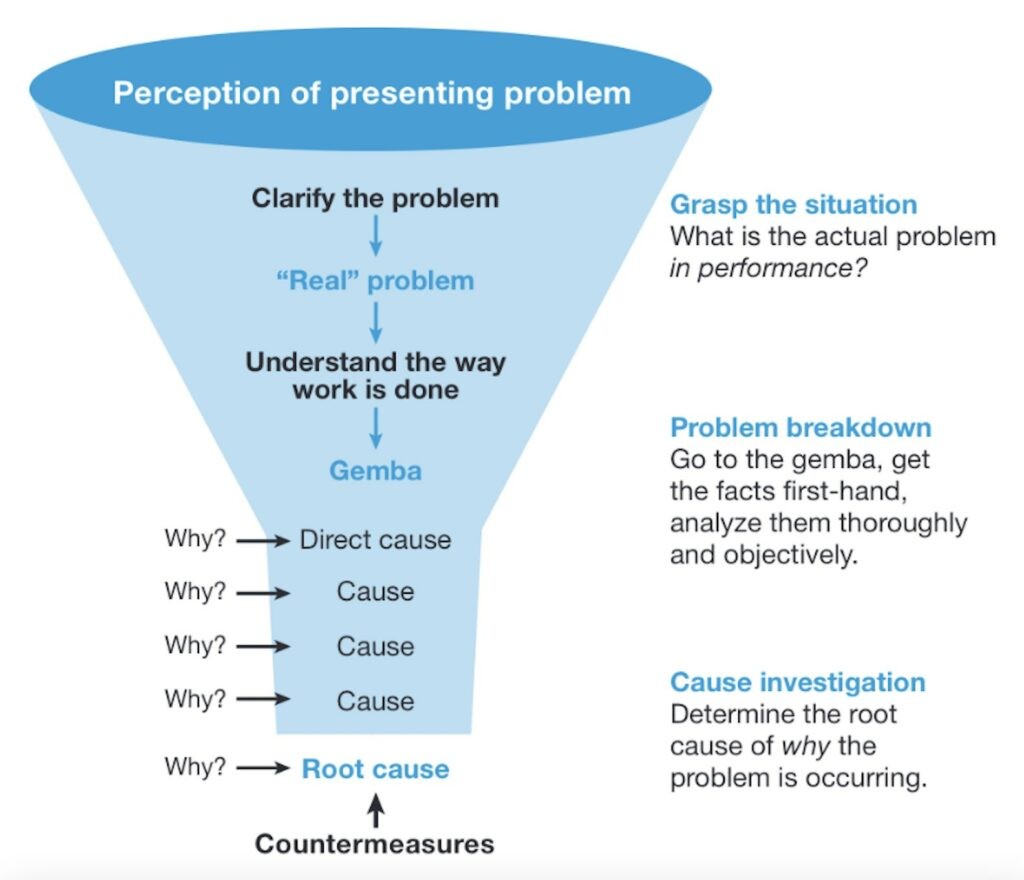The Five Whys method is a powerful problem-solving technique used to delve beneath the surface of symptoms and uncover the fundamental root cause of an issue. This method involves repeatedly asking “why” – typically five times, but potentially more or less – to explore the cause-and-effect relationships underlying a problem. By iteratively questioning the reasons behind each problem, the Five Whys helps to identify the specific factor that, once addressed, will prevent the issue from recurring.
What is the Five Why Method?
Originating from Toyota and popularized by Taiichi Ohno, one of the architects of the Toyota Production System, the Five Whys technique is deceptively simple yet remarkably effective. It operates on the principle that symptoms are often mistaken for the real problem, and only by persistent inquiry can you reach the true source.
Consider this classic example, provided by Ohno himself, concerning a machine malfunction (Ohno, 1988):
- Why did the machine stop? The circuit overloaded, causing a fuse to blow.
- Why did the circuit overload? The bearing lacked sufficient lubrication.
- Why was the bearing not sufficiently lubricated? The lubrication pump wasn’t pumping adequately.
- Why was the pump not pumping adequately? The pump shaft was worn and vibrating.
- Why was the shaft worn out? Metal debris entered due to the absence of a strainer.
In this scenario, simply replacing the fuse or even the pump would only be temporary fixes. The problem would inevitably resurface. The Five Whys method guides us to the root cause: the missing strainer. Addressing this root cause by installing a strainer prevents future occurrences of the machine stoppage. The “five” in Five Whys is not a rigid limit but rather a guideline to encourage thorough investigation until the core issue is identified and resolved.
When to Apply the Five Why Method for Problem-Solving
The Five Whys method is particularly useful when tackling “Gap from Standard” problems. These are situations where actual performance deviates from the expected standard or desired outcome. This problem-solving approach is structured and involves several key steps:
- Clearly Define the Problem: Start with a precise description of the problem you are facing.
- Set Measurable Goals: Define what success looks like in solving the problem.
- Conduct Root Cause Analysis: This is where the Five Whys method comes into play, helping you to systematically drill down to the core issue.
- Establish Countermeasures: Develop specific actions to address the identified root cause.
- Implement Checks and Standards: Put in place processes to monitor the effectiveness of the countermeasures and prevent recurrence.
- Follow-up Activities: Regularly review and adjust your approach as needed to ensure long-term problem resolution.
While there are various methods for root cause analysis, they can generally be categorized into three types:
- Logic-Based Methods: Techniques like the Five Whys fall into this category, relying on logical deduction and reasoning to trace the problem back to its origin.
- One-Variable-at-a-Time (OVAT): This approach involves changing one variable at a time to observe its effect on the problem.
- Multivariate-at-a-Time (MVAT): MVAT methods examine the simultaneous impact of multiple variables on the problem.
The Five Whys method stands out for its simplicity and accessibility. It requires no advanced statistical knowledge, focusing instead on critical thinking and logical reasoning. It leverages inductive logic (moving from specific observations to broader generalizations), deductive logic (applying general principles to specific situations), and abductive logic (forming hypotheses from observations) to effectively pinpoint root causes.
Conclusion
The Five Why Method is a valuable tool for anyone seeking to solve problems effectively and prevent their recurrence. Its simplicity makes it easy to learn and apply across various contexts, from manufacturing to service industries and even in personal life. By consistently asking “why,” you can move beyond superficial fixes and implement solutions that address the true source of the problem, leading to lasting improvements.
Further Resources:
For deeper exploration of problem-solving methodologies, consider exploring resources on:
- Kaizen
- Plan, Do, Check, Act (PDCA)
Synonyms: 5 Whys, Five-Whys

